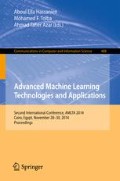Abstract
Malignant melanoma is the deadliest form of skin cancer and is one of the most rapidly increasing cancers in the world. If diagnosed early, it can be easily cured, and consequently early diagnosis of melanoma is of vital importance. In this paper, we present an effective approach to melanoma classification from dermoscopy images of skin lesions. First, we perform automatic border detection to delineate the lesion from the background skin. We then extract shape features from the border, while colour and texture features are obtained based on a division of the image into clinically significant regions using a Euclidean distance transform. The derived features are then used in a pattern classification stage for which we employ a dedicated ensemble learning approach to address the class imbalance in the training data. In particular, we employ a committee of one-class classifiers for that purpose. One-class classification uses samples from a single distribution to derive a decision boundary, and employing this method on the minority class can significantly boost its recognition rate and hence the sensitivity of our approach. We combine several one-class classifiers using a random subspace approach and a diversity measure to select members of the committee. Experimental results on a large dataset of dermoscopic skin lesion images show our approach to work well, the employed classifier selection stage to be crucial for achieving this performance, and the classifier ensembles to perform statistically better compared to several state-of-the-art ensembles.
Access this chapter
Tax calculation will be finalised at checkout
Purchases are for personal use only
Preview
Unable to display preview. Download preview PDF.
References
Alpaydin, E.: Combined 5 x 2 CV F test for comparing supervised classification learning algorithms. Neural Computation 11(8), 1885–1892 (1999)
Argenziano, G., Soyer, H.P., De Giorgi, V.: Dermoscopy: A Tutorial. EDRA Medical Publishing & New Media (2002)
Binder, M., Schwarz, M., Winkler, A., Steiner, A., Kaider, A., Wolff, K., Pehamberger, H.: Epiluminescence microscopy. a useful tool for the diagnosis of pigmented skin lesions for formally trained dermatologists. Archives of Dermatology 131(3), 286–291 (1995)
Błaszczyński, J., Deckert, M., Stefanowski, J., Wilk, S.: Integrating selective pre-processing of imbalanced data with Ivotes ensemble. In: Szczuka, M., Kryszkiewicz, M., Ramanna, S., Jensen, R., Hu, Q. (eds.) RSCTC 2010. LNCS (LNAI), vol. 6086, pp. 148–157. Springer, Heidelberg (2010)
Celebi, M.E., Aslandogan, Y.A., Stoecker, W.V., Iyatomi, H., Oka, H., Chen, X.: Unsupervised border detection in dermoscopy images. Skin Research and Technology 13(4), 454–462 (2007)
Celebi, M.E., Kingravi, H., Uddin, B., Iyatomi, H., Aslandogan, A., Stoecker, W.V., Moss, R.H.: A methodological approach to the classification of dermoscopy images. Computerized Medical Imaging and Graphics 31(6), 362–373 (2007)
Celebi, M., Iyatomi, H., Schaefer, G., Stoecker, W.: Lesion border detection in dermoscopy images. Computerized Medical Imaging and Graphics 33(2), 148–153 (2009)
Chawla, N.V., Bowyer, K.W., Hall, L.O., Kegelmeyer, W.P.: SMOTE: Synthetic minority over-sampling technique. Journal of Artificial Intelligence Research 16, 321–357 (2002)
Chawla, N.V., Lazarevic, A., Hall, L.O., Bowyer, K.W.: SMOTEBoost: improving prediction of the minority class in boosting. In: Lavrač, N., Gamberger, D., Todorovski, L., Blockeel, H. (eds.) PKDD 2003. LNCS (LNAI), vol. 2838, pp. 107–119. Springer, Heidelberg (2003)
Deng, Y., Manjunath, B.S.: Unsupervised segmentation of color-texture regions in images and video. IEEE Trans. Pattern Analysis and Machine Intelligence 23(8), 800–810 (2001)
Fleming, M.G., Steger, C., Zhang, J., Gao, J., Cognetta, A.B., Pollak, I., Dyer, C.R.: Techniques for a structural analysis of dermatoscopic imagery. Computerized Medical Imaging and Graphics 22(5), 375–389 (1998)
Haralick, R.M.: Statistical and structural approaches to texture. Proceedings of the IEEE 67(5), 786–804 (1979)
Koch, M.W., Moya, M.M., Hostetler, L.D., Fogler, R.J.: Cueing, feature discovery, and one-class learning for synthetic aperture radar automatic target recognition. Neural Networks 8(7-8), 1081–1102 (1995)
Kuncheva, L.I., Whitaker, C.J.: Ten measures of diversity in classifier ensembles: limits for two classifiers. In: IEE Workshop on Intelligent Sensor Processing, pp. 10/1–10/6 (2001)
Liu, X., Wu, J., Zhou, Z.: Exploratory undersampling for class-imbalance learning. IEEE Trans. Systems, Man and Cybernetics - Part B: Cybernetics 39(2), 539–550 (2009)
Menzies, S.W., Crotty, K.A., Ingwar, C., McCarth, W.H.: An atlas of surface microscopy of pigmented skin lesions: dermoscopy, 2nd edn. McGraw-Hill (2003)
Siegel, R., Naishadham, D., Jemal, A.: Cancer statistics, 2013. CA: A Cancer Journal for Clinicians 63(1), 11–30 (2013)
Steiner, K., Binder, M., Schemper, M., Wolff, K., Pehamberger, H.: Statistical evaluation of epiluminescence dermoscopy criteria for melanocytic pigmented lesions. Journal of the American Academy of Dermatology 29(4), 581–588 (1993)
Tax, D.M.J., Duin, R.P.W.: Combining one-class classifiers. In: Kittler, J., Roli, F. (eds.) MCS 2001. LNCS, vol. 2096, pp. 299–308. Springer, Heidelberg (2001)
Tax, D.M.J., Duin, R.P.W.: Support vector data description. Machine Learning 54(1), 45–66 (2004)
Vapnik, V.N.: Statistical Learning Theory. John Wiley & Sons (1998)
Wang, S., Yao, X.: Diversity analysis on imbalanced data sets by using ensemble models. In: IEEE Symposium on Computational Intelligence and Data Mining, pp. 324–331 (2009)
Wozniak, M., Zmyslony, M.: Designing combining classifier with trained fuser – analytical and experimental evaluation. Neural Network World 20(7), 925–934 (2010)
Author information
Authors and Affiliations
Editor information
Editors and Affiliations
Rights and permissions
Copyright information
© 2014 Springer International Publishing Switzerland
About this paper
Cite this paper
Schaefer, G., Krawczyk, B., Celebi, M.E., Iyatomi, H., Hassanien, A.E. (2014). Melanoma Classification Based on Ensemble Classification of Dermoscopy Image Features. In: Hassanien, A.E., Tolba, M.F., Taher Azar, A. (eds) Advanced Machine Learning Technologies and Applications. AMLTA 2014. Communications in Computer and Information Science, vol 488. Springer, Cham. https://doi.org/10.1007/978-3-319-13461-1_28
Download citation
DOI: https://doi.org/10.1007/978-3-319-13461-1_28
Publisher Name: Springer, Cham
Print ISBN: 978-3-319-13460-4
Online ISBN: 978-3-319-13461-1
eBook Packages: Computer ScienceComputer Science (R0)

